Supporting Heterogenous Traffic on Top of Point-to-Multipoint Light-Trees †
Abstract
1. Introduction
2. Optical Layer Supporting P2P and P2MP Traffic
3. Optical Constellation Slicing
4. Illustrative Results
4.1. Performance Evaluation of DSCM and OCS for Optical P2MP
4.2. Quantitative Analysis
5. Conclusions
Author Contributions
Funding
Institutional Review Board Statement
Informed Consent Statement
Data Availability Statement
Conflicts of Interest
References
- Hou, Z.; She, C.; Li, Y.; Niyato, D.; Dohler, M.; Vucetic, B. Intelligent Communications for Tactile Internet in 6G: Requirements, Technologies, and Challenges. IEEE Commun. Mag. 2021, 59, 82–88. [Google Scholar] [CrossRef]
- Velasco, L.; Wright, P.; Lord, A.; Junyent, G. Saving CAPEX by Extending Flexgrid-based Core Optical Networks towards the Edges [Invited]. J. Opt. Commun. Netw. 2013, 5, A171–A183. [Google Scholar] [CrossRef]
- Bao, B.; Yang, H.; Yao, Q.; Guan, L.; Zhang, J.; Cheriet, M. Resource Allocation with Edge-Cloud Collaborative Traffic Prediction in Integrated Radio and Optical Networks. IEEE Access 2023, 11, 7067–7077. [Google Scholar] [CrossRef]
- Giordani, M.; Polese, M.; Mezzavilla, M.; Rangan, S.; Zorzi, M. Toward 6G Networks: Use Cases and Technologies. IEEE Commun. Mag. 2020, 58, 55–61. [Google Scholar] [CrossRef]
- Welch, D.; Napoli, A.; Bäck, J.; Sande, W.; Pedro, J.; Masoud, F.; Fludger, C.; Duthel, T.; Sun, T.; Hand, H.; et al. Point-to-Multipoint Optical Networks Using Coherent Digital Subcarriers. IEEE/OSA J. Light. Technol. 2021, 39, 5232–5247. [Google Scholar] [CrossRef]
- Ruiz, M.; Velasco, L. Serving Multicast Requests on Single Layer and Multilayer Flexgrid Networks. IEEE/OSA J. Opt. Commun. Netw. 2015, 7, 146–155. [Google Scholar] [CrossRef]
- Ruiz, M.; Velasco, L. Performance Evaluation of Light-tree Schemes in Flexgrid Optical Networks. IEEE Commun. Lett. 2014, 18, 1731–1734. [Google Scholar] [CrossRef]
- Savory, S. Digital Signal Processing for Coherent Optical Communication Systems. In Proceedings of the 2013 18th OptoElectronics and Communications Conference held jointly with 2013 International Conference on Photonics in Switching (OECC/PS), Kyoto, Japan, 30 June–4 July 2013. [Google Scholar]
- Sequeira, D.; Ruiz, M.; Costa, N.; Napoli, A.; Pedro, J.; Velasco, L. Accurate Low Complex Modulation Format and Symbol Rate Identification for Autonomous Lightpath Operation. Sensors 2022, 22, 9251. [Google Scholar] [CrossRef] [PubMed]
- Welch, D.; Napoli, A.; Bäck, J.; Swenson, N.; Sande, W.; Pedro, J.; Masoud, F.; Chase, A.; Fludger, C.; Sun, H.; et al. Digital Subcarriers: A Universal Technology for Next Generation Optical Networks. In Proceedings of the Optical Fiber Communications Conference and Exhibition (OFC), San Diego, CA, USA, 6–10 March 2022. [Google Scholar]
- Qiu, M.; Zhuge, Q.; Chagnon, M.; Gao, Y.; Xu, X.; Morsy-Osman, M.; Plant, D. Digital Subcarrier Multiplexing for Fiber NonLinearity Mitigation in Coherent Optical Communication Systems. Opt. Express 2022, 22, 18770–18777. [Google Scholar] [CrossRef] [PubMed]
- Velasco, L.; Barzegar, S.; Sequeira, D.; Ferrari, A.; Costa, N.; Curri, V.; Pedro, J.; Napoli, A.; Ruiz, M. Autonomous and Energy Efficient Lightpath Operation based on Digital Subcarrier Multiplexing. IEEE J. Sel. Areas Commun. 2021, 39, 2864–2877. [Google Scholar] [CrossRef]
- Bäck, J.; Wright, P.; Ambrose, J.; Chase, A.; Jary, M.; Masoud, F.; Sugden, N.; Wardrop, G.; Napoli, A.; Pedro, J.; et al. CAPEX Savings Enabled by Point-to-Multipoint Coherent Pluggable Optics Using Digital Subcarrier Multiplexing in Metro Aggregation Networks. In Proceedings of the 2020 European Conference on Optical Communications (ECOC), Brussels, Belgium, 6–10 December 2020. [Google Scholar]
- Dar, R.; Winzer, P. Digital Subcarrier Multiplexing in Optically Routed Networks. In Proceedings of the Optical Fiber Communication Conference, Los Angeles, CA, USA, 19–23 March 2017. [Google Scholar]
- Welch, D.; Napoli, A.; Back, J.; Buggaveeti, S.; Castro, C.; Chase, A.; Chen, X.; Dominic, V.; Duthel, T.; Eriksson, T.A.; et al. Digital Subcarrier Multiplexing: Enabling Software-Configurable Optical Networks. J. Light. Technol. 2023, 41, 1175–1191. [Google Scholar] [CrossRef]
- Iqbal, M.; Ruiz, M.; Costa, N.; Napoli, A.; Pedro, J.; Velasco, L. Dynamic and Efficient Point-to-Point and Point-to-Multipoint Communications by Slicing the Optical Constellation. In Proceedings of the Optical Fiber Communication Conference (OFC), San Diego, CA, USA, 6–10 March 2022. [Google Scholar]
- Hernandez, J.; Quagliotti, M.; Serra, L.; Luque, L.; da Silva, R.; Rafel, A.; Gonzalez de Dios, O.; López, V.; Eira, A.; Casellas, R.; et al. Comprehensive Model for Technoeconomic Studies of Next-Generation Central Offices for Metro Networks. IEEE/OSA J. Opt. Commun. Netw. 2020, 12, 414–427. [Google Scholar] [CrossRef]
- Pedrola, O.; Castro, A.; Velasco, L.; Ruiz, M.; Fernández-Palacios, J.P.; Careglio, D. CAPEX Study for Multilayer IP/MPLS Over Flexgrid Optical Network. IEEE/OSA J. Opt. Commun. Netw. 2012, 4, 639–650. [Google Scholar] [CrossRef]
- Salomon, D. Coding for Data and Computer Communications; Springer: Berlin/Heidelberg, Germany, 2005. [Google Scholar]
- Iqbal, M.; Velasco, L.; Costa, N.; Napoli, A.; Pedro, J.; Ruiz, M. LPsec: A Fast and Secure Cryptographic System for Optical Connections. IEEE/OPTICA J. Opt. Commun. Netw. 2022, 14, 278–288. [Google Scholar] [CrossRef]
- Agrawal, G. Nonlinear Fiber Optics, 5th ed.; Springer: Berlin/Heidelberg, Germany, 2013. [Google Scholar]
- Alimi, I.; Patel, R.; Silva, N.; Sun, C.; Ji, H.; Shieh, W.; Pinto, A.; Muga, N. A Review of Self-Coherent Optical Transceivers: Fundamental Issues. Recent Advances, and Research Directions. Appl. Sci. 2021, 11, 7554. [Google Scholar] [CrossRef]
- Ruiz, M.; Coltraro, F.; Velasco, L. CURSA-SQ: A Methodology for Service-Centric Traffic Flow Analysis. IEEE/OSA J. Opt. Commun. Netw. 2018, 10, 773–784. [Google Scholar] [CrossRef]
- Hosseini, M.; Pedro, J.; Napoli, A.; Costa, N.; Prilepsky, J.; Turitsyn, S. Optimization of Survivable Filterless Optical Networks Exploiting Digital Subcarrier Multiplexing. IEEE/OPTICA J. Opt. Commun. Netw. 2022, 14, 586–594. [Google Scholar] [CrossRef]
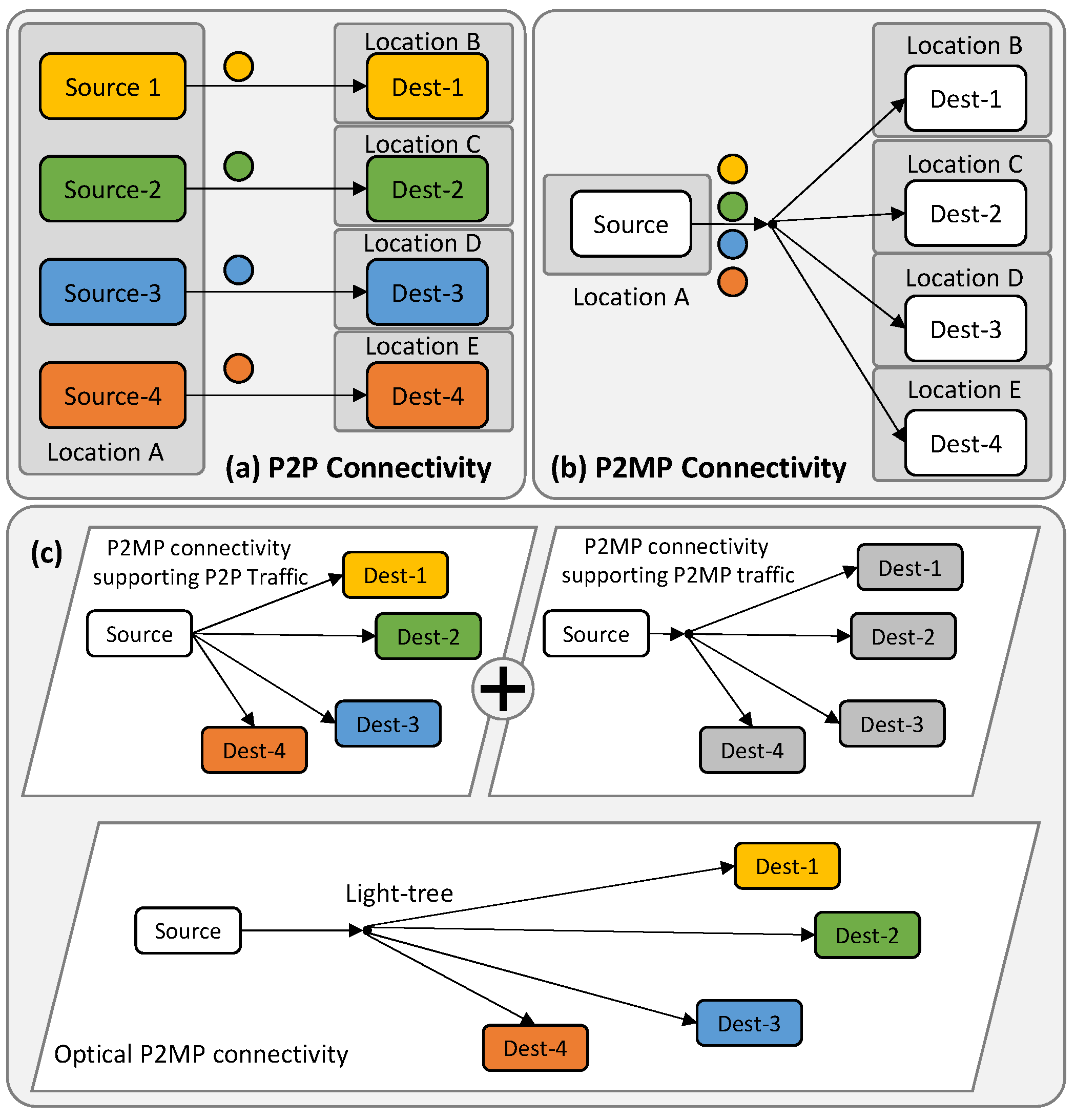
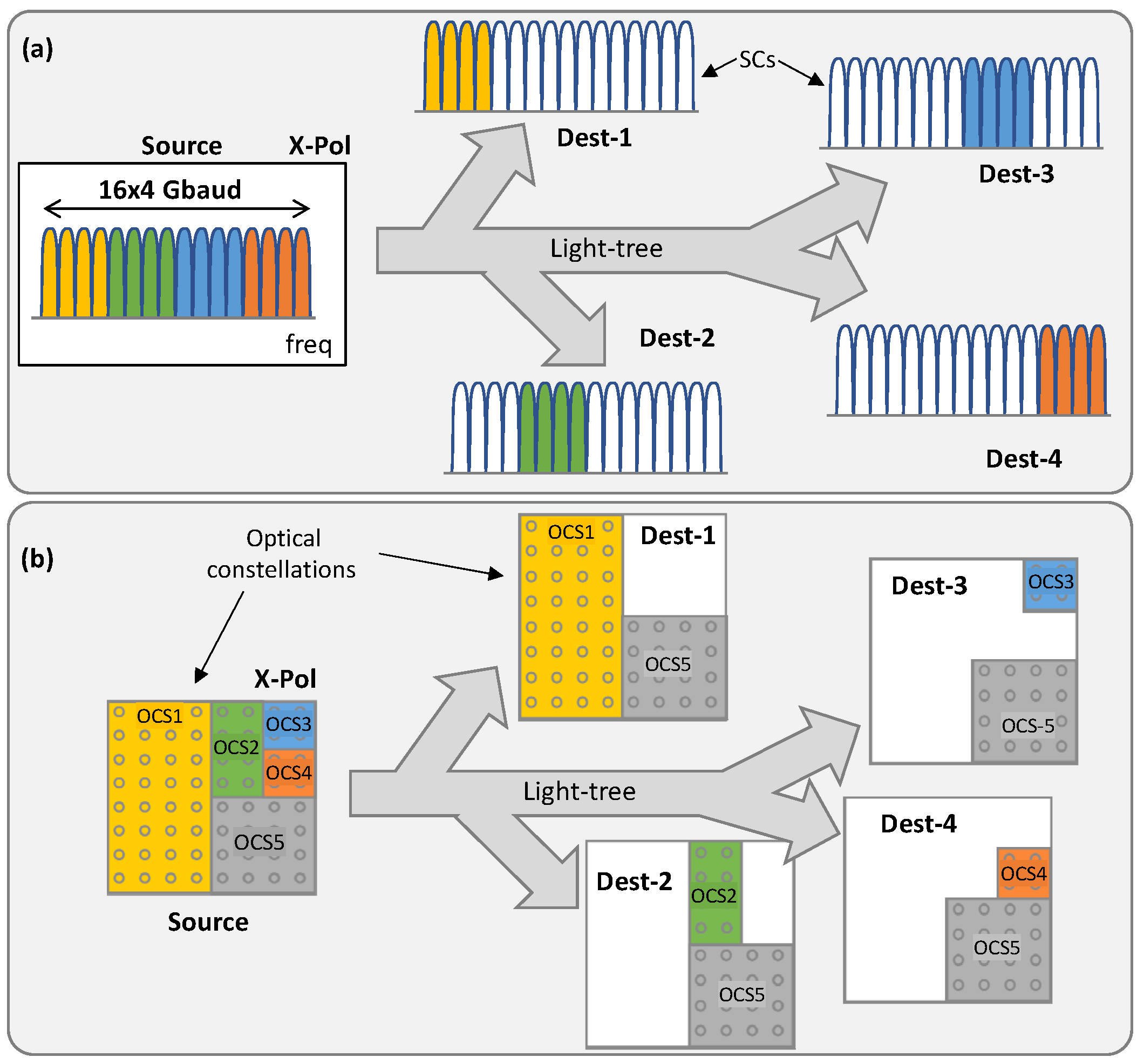
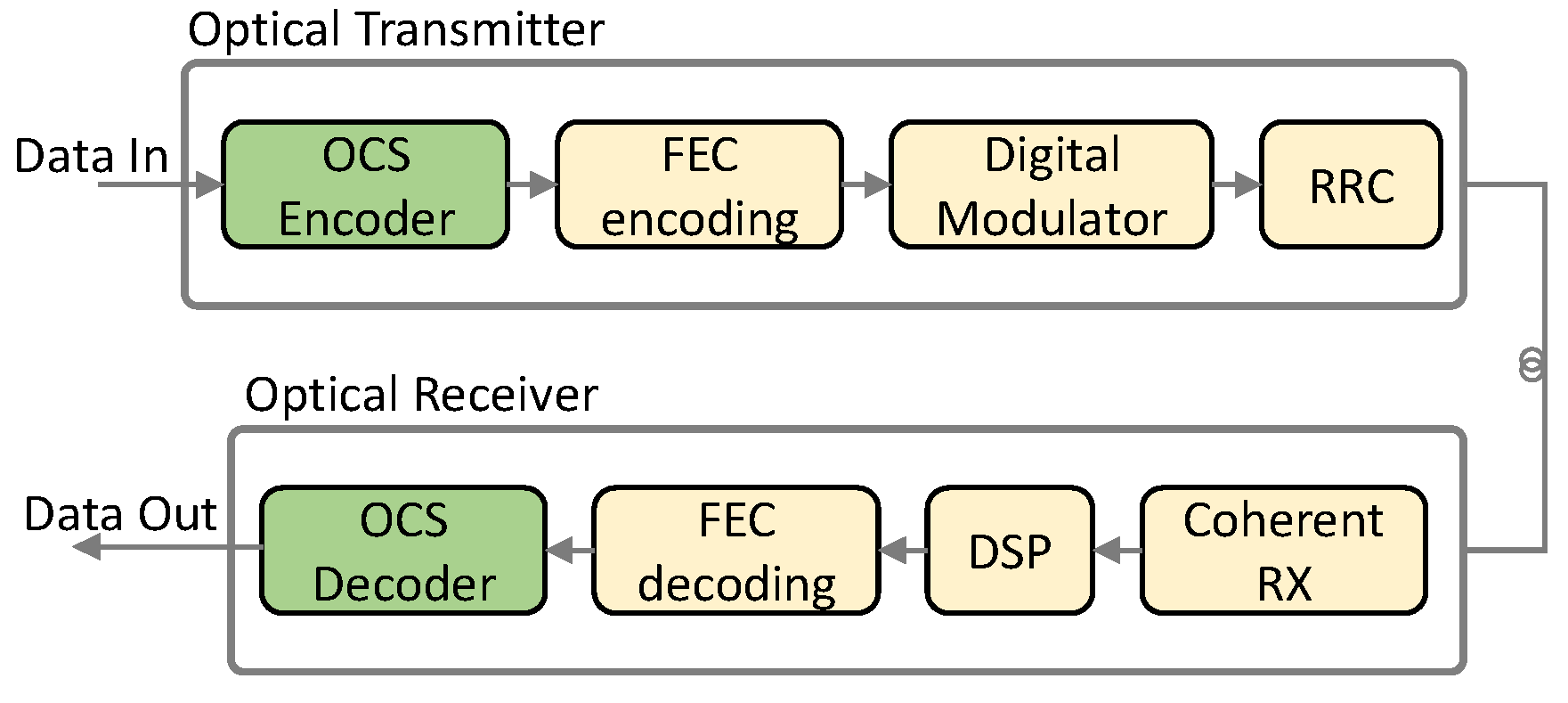

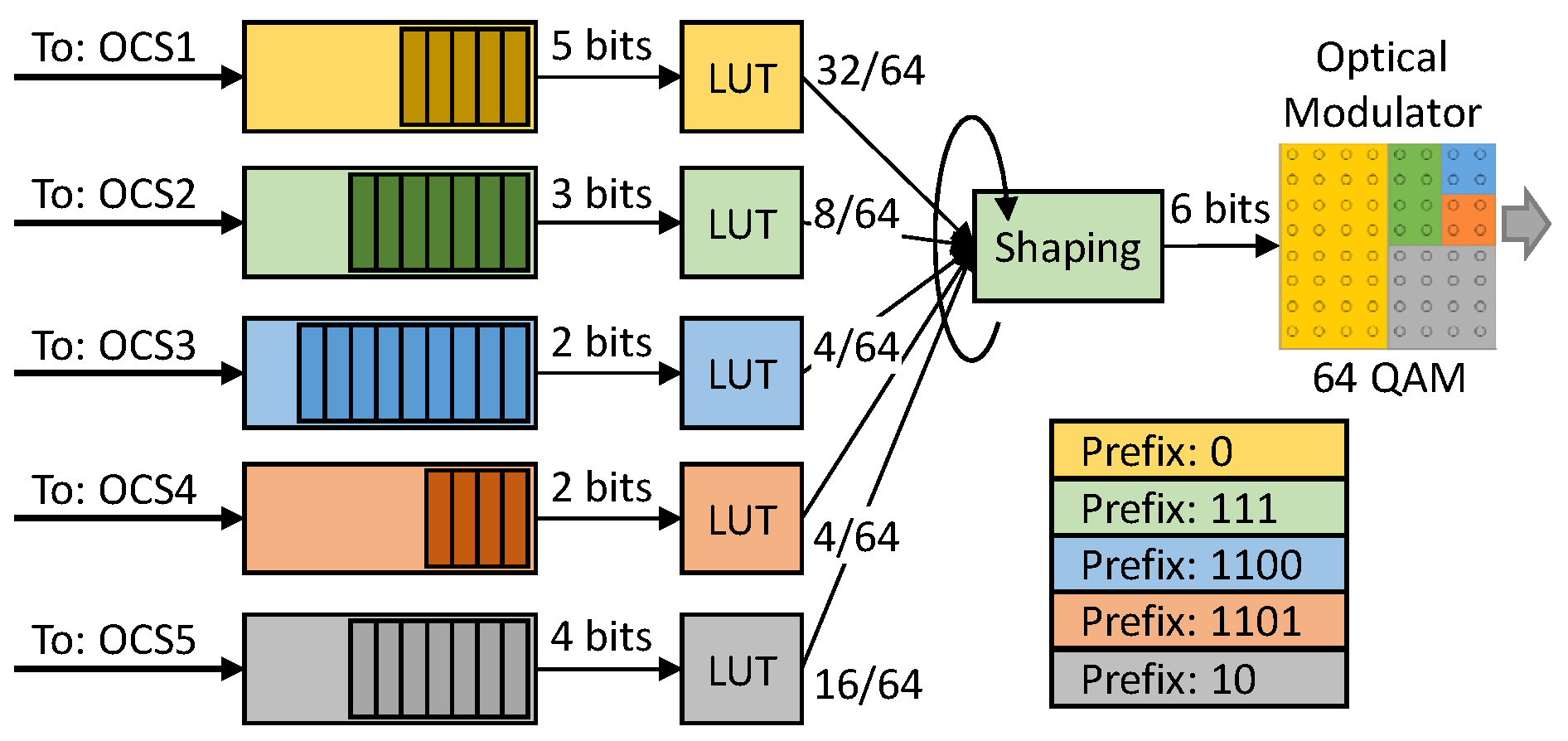
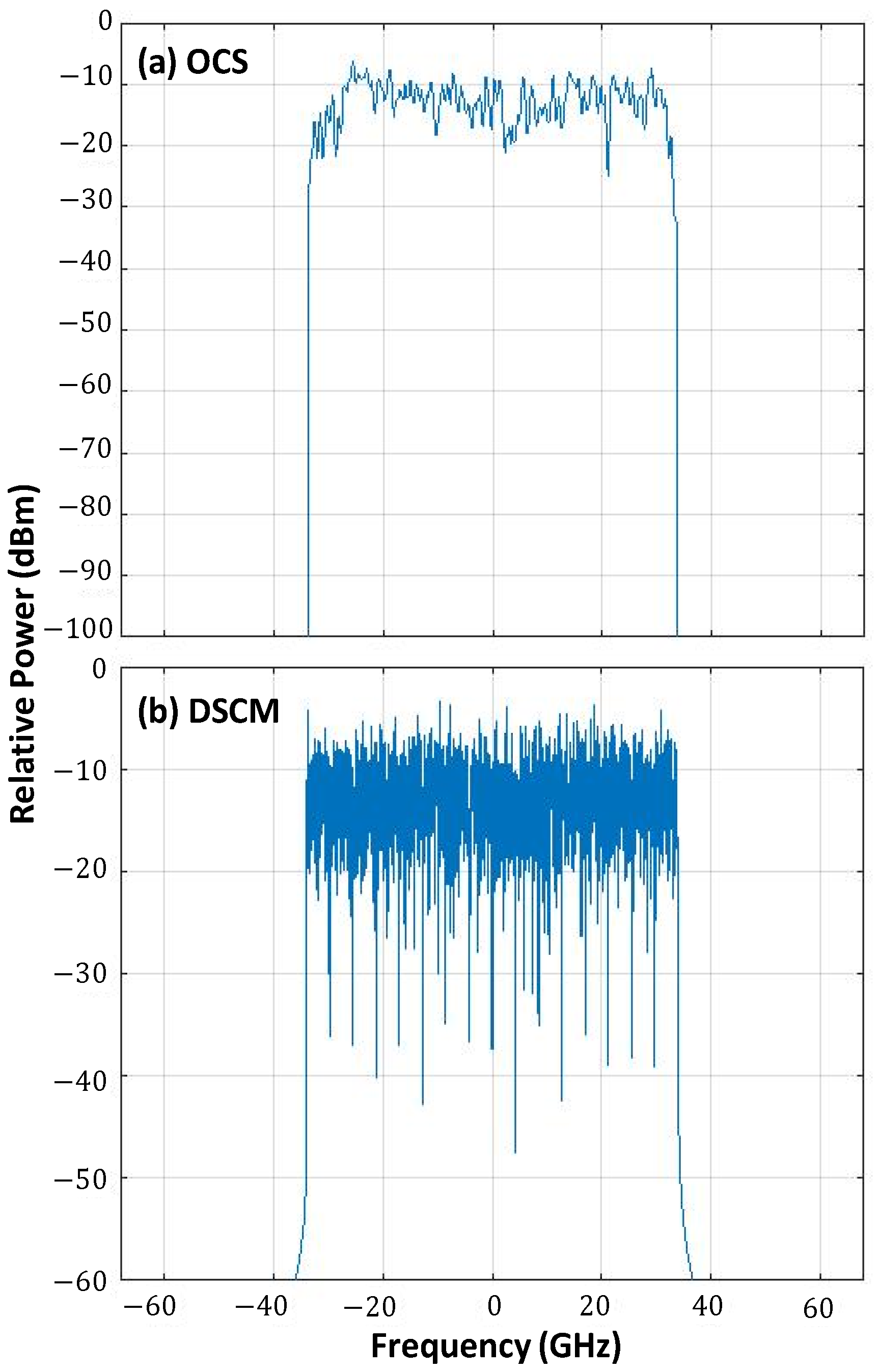


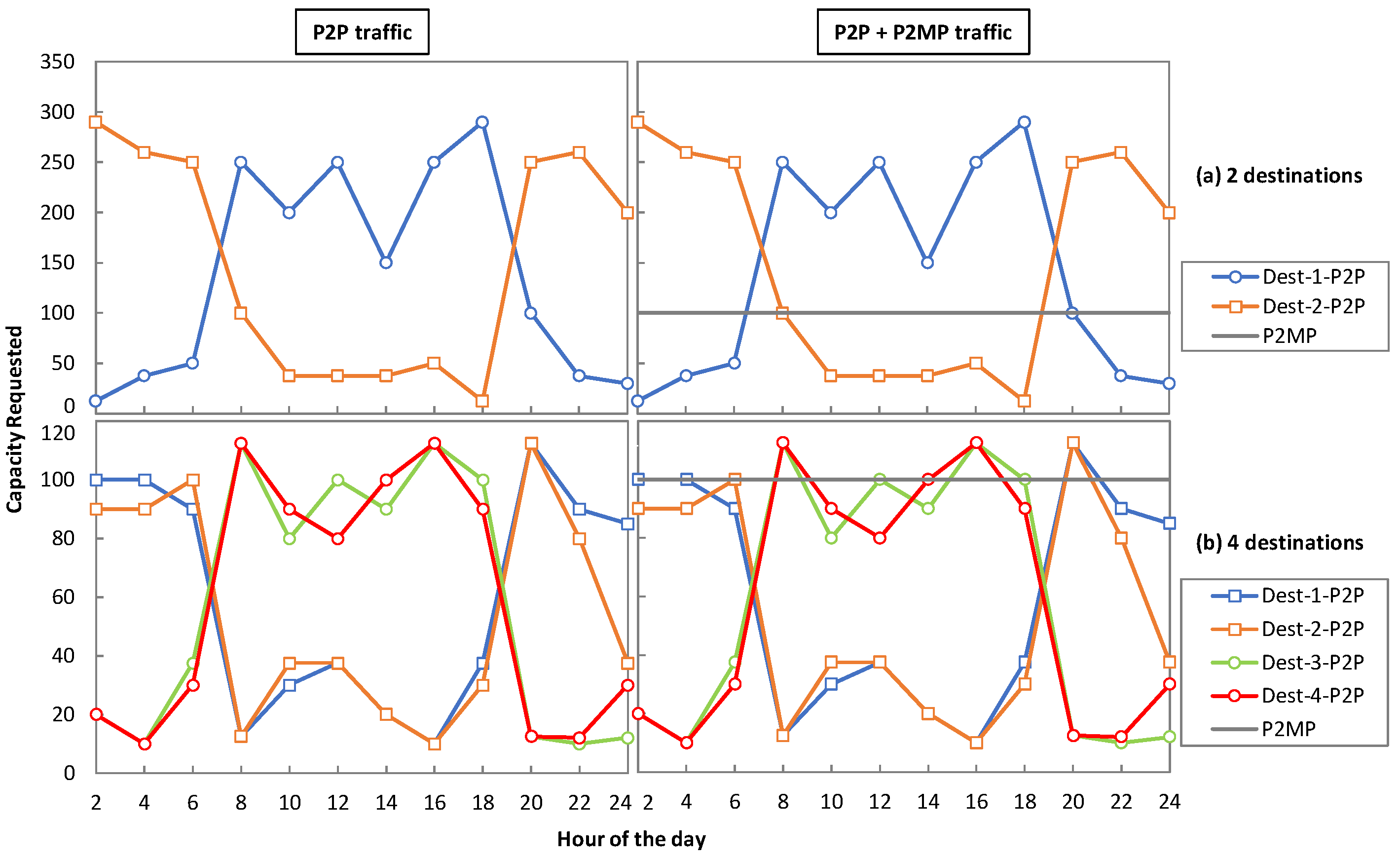
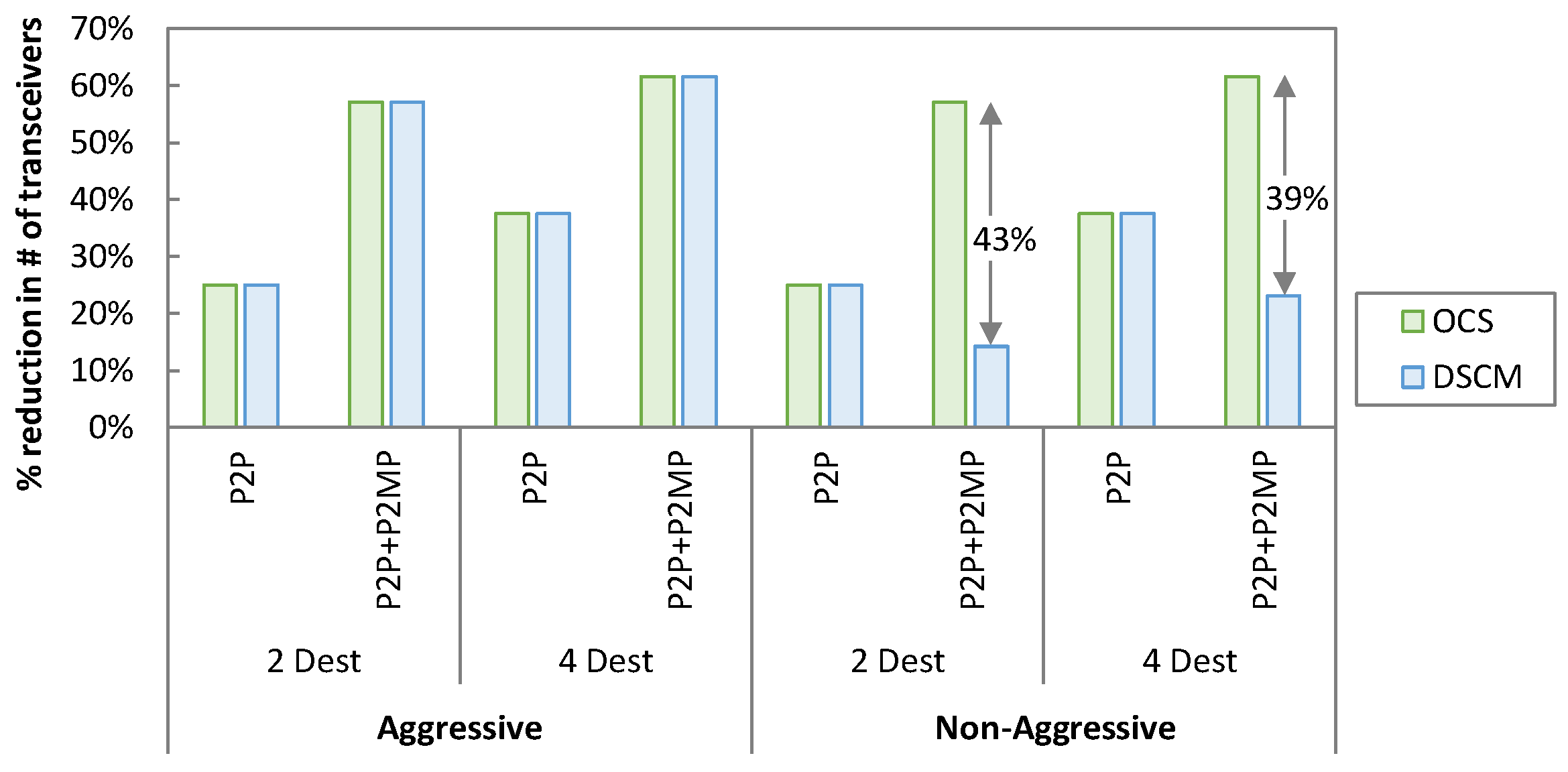
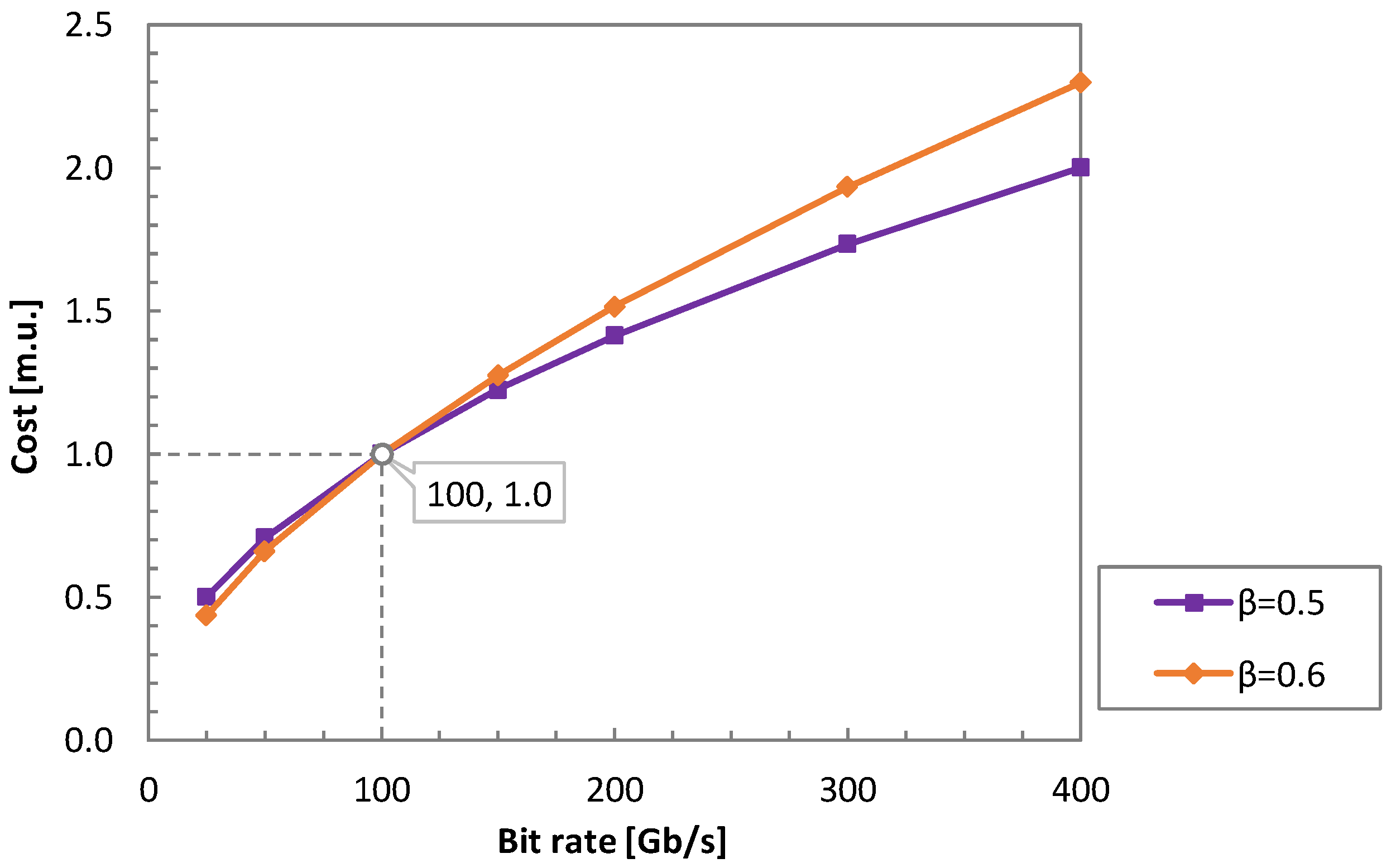
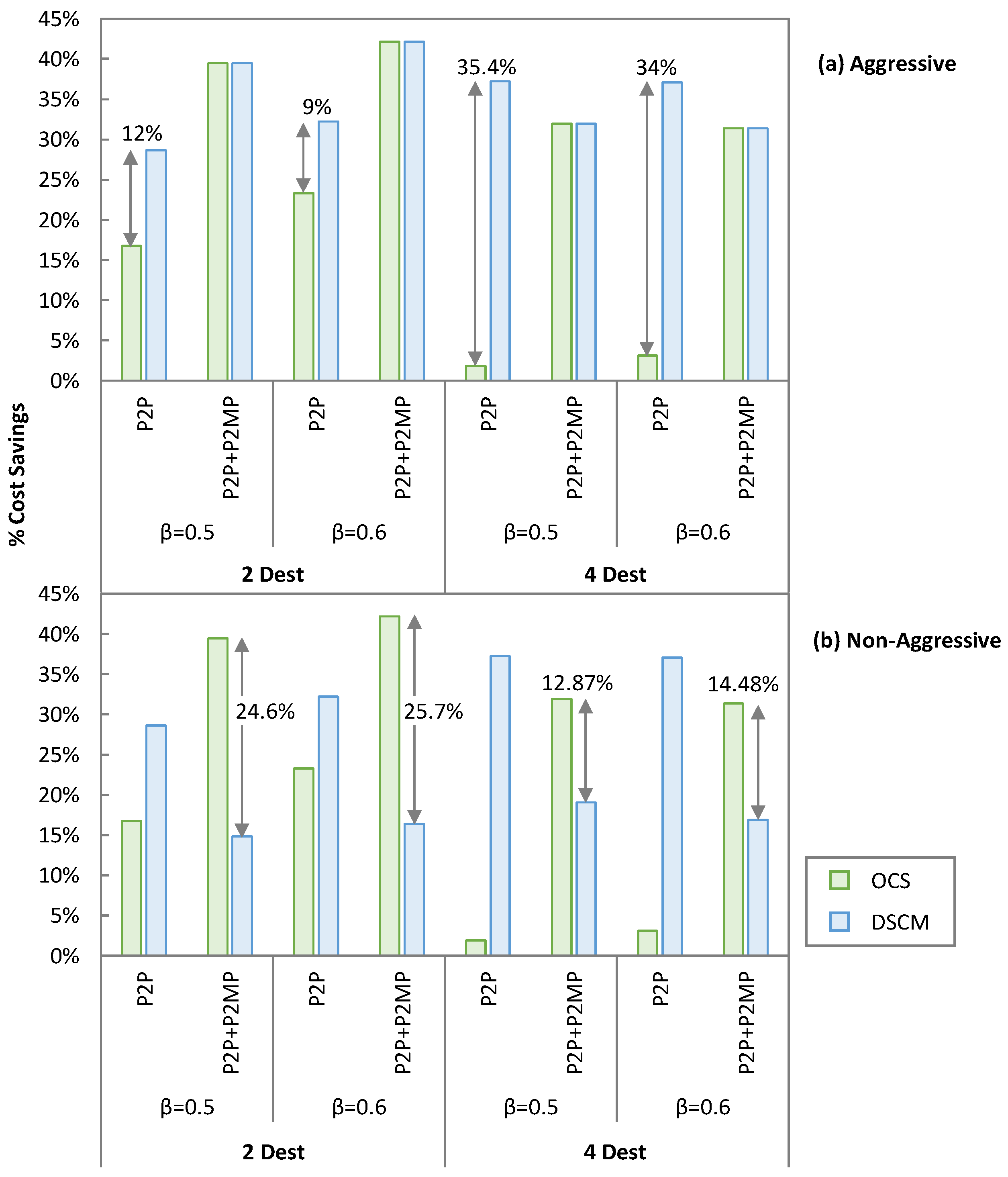
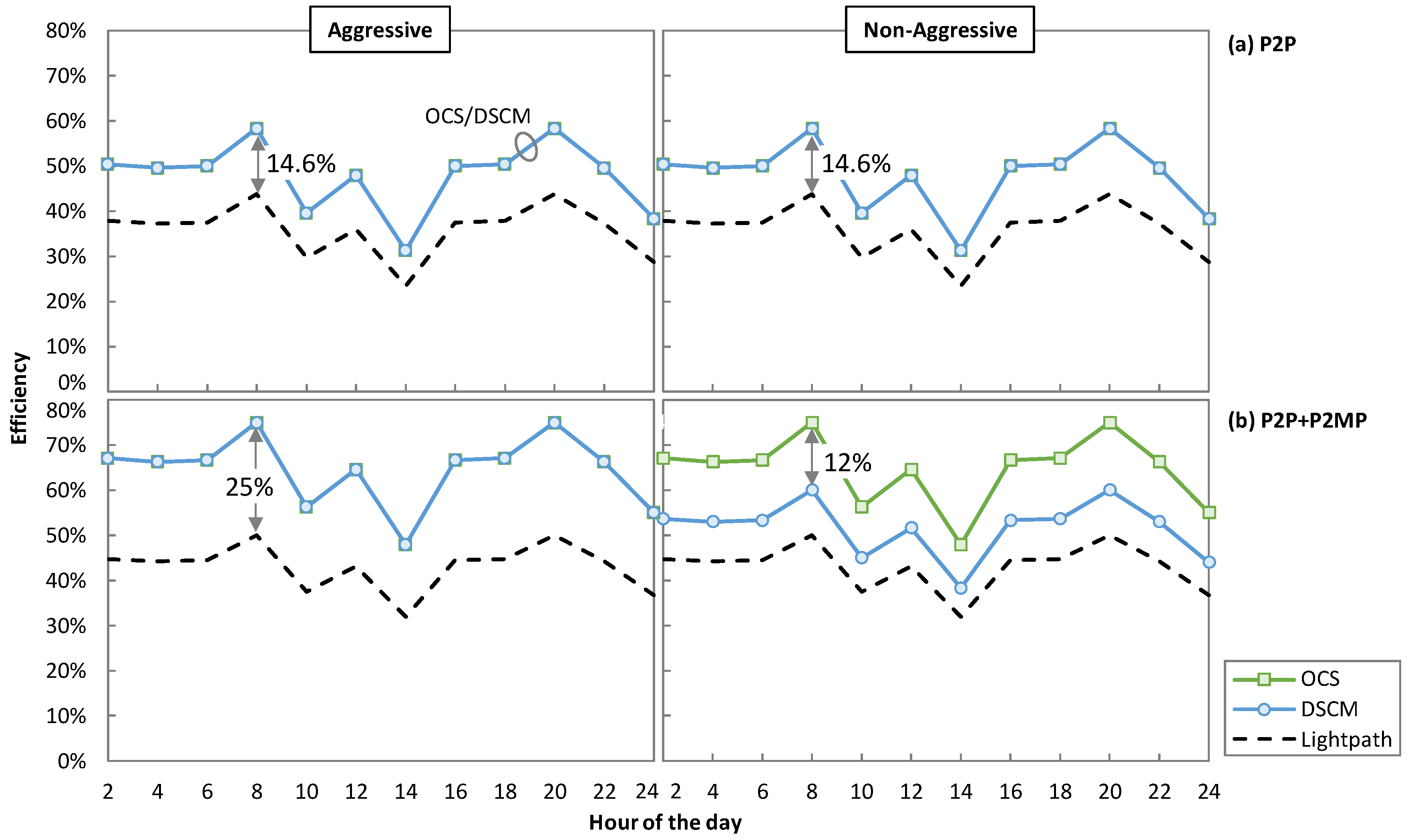
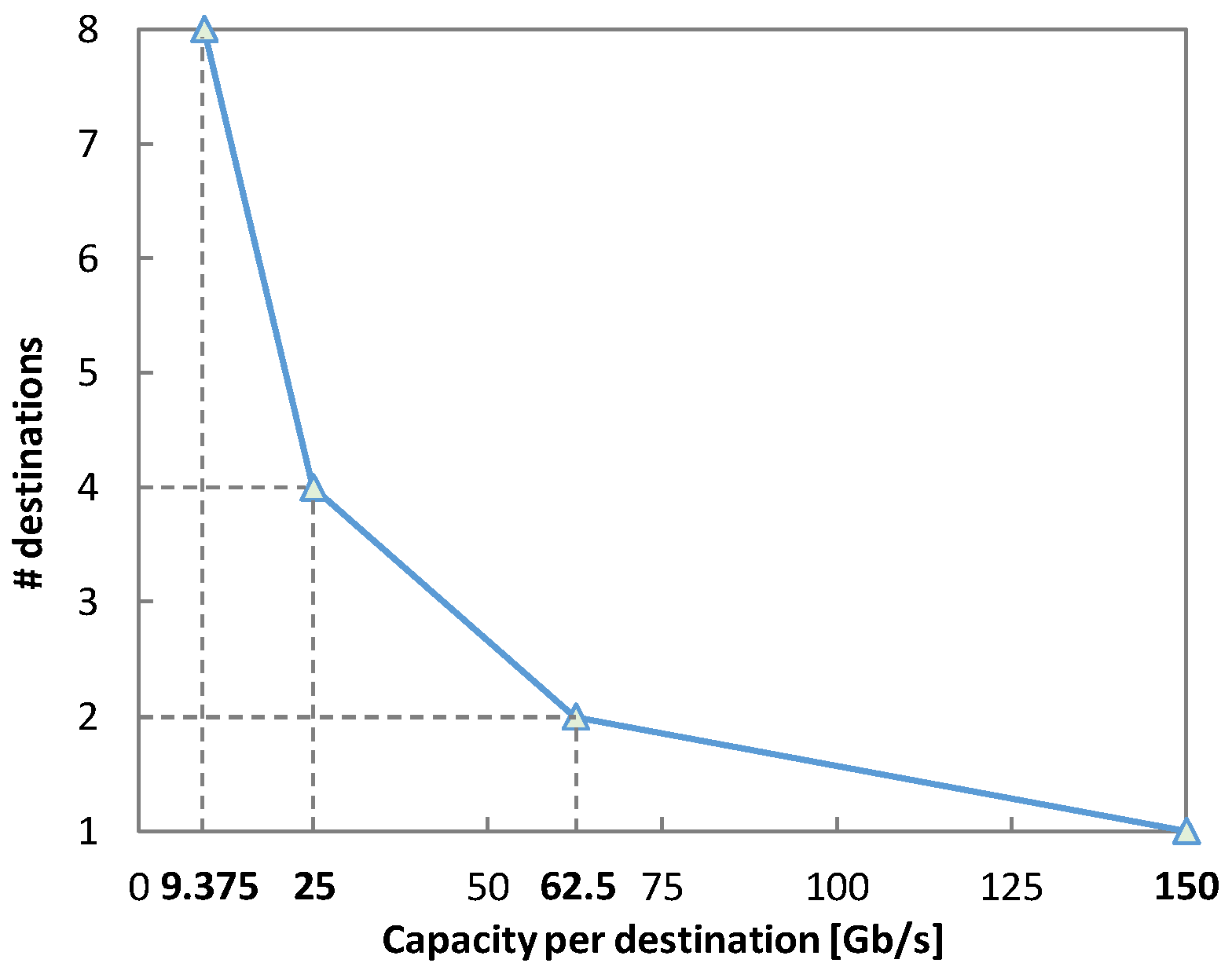
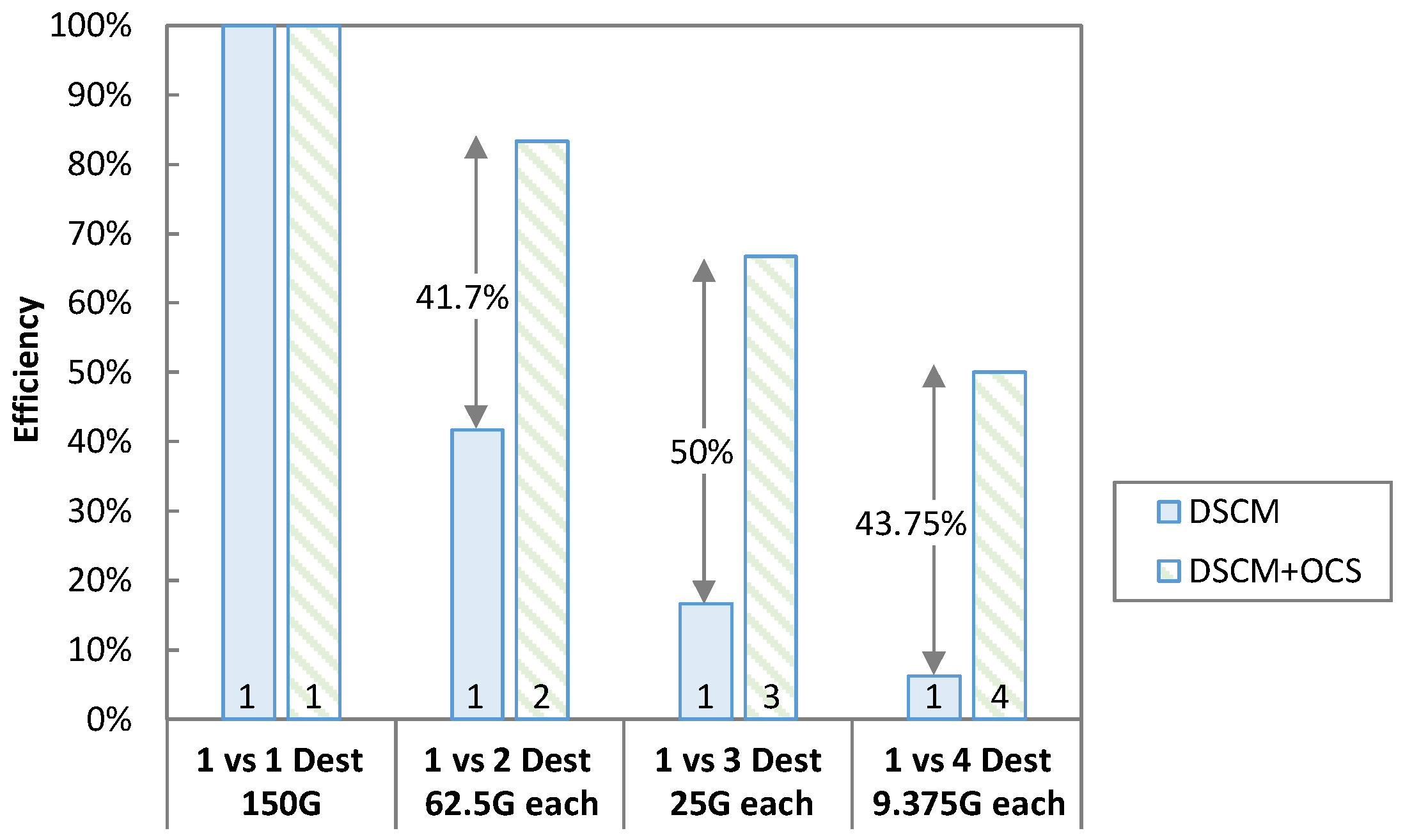
| OCS # | #CP | Throughput [Gb/s] | SE [%] | CE [%] |
|---|---|---|---|---|
| 1 | 32 | 250 | 83.3 | 41.7 |
| 2 | 8 | 37.5 | 50.0 | 6.3 |
| 3 | 4 | 12.5 | 33.3 | 2.1 |
| 4 | 4 | 12.5 | 33.3 | 2.1 |
| 5 | 16 | 100 | 66.7 | 16.7 |
| Total | 412.5 | -- | 68.80 |
| P2P | OCS | DSCM | |
|---|---|---|---|
| 25 G 50 G 100 G 200 G 400 G | 600 G 64-QAM @64GBd DP | 600 G 64-QAM @64GBd DP | 150 G 4 SCs per polarization 300 G 8 SCs per polarization 600 G 16 SCs per polarization |
Disclaimer/Publisher’s Note: The statements, opinions and data contained in all publications are solely those of the individual author(s) and contributor(s) and not of MDPI and/or the editor(s). MDPI and/or the editor(s) disclaim responsibility for any injury to people or property resulting from any ideas, methods, instructions or products referred to in the content. |
© 2023 by the authors. Licensee MDPI, Basel, Switzerland. This article is an open access article distributed under the terms and conditions of the Creative Commons Attribution (CC BY) license (https://creativecommons.org/licenses/by/4.0/).
Share and Cite
Iqbal, M.; Velasco, L.; Ruiz, M.; Costa, N.; Napoli, A.; Pedro, J.; Comellas, J. Supporting Heterogenous Traffic on Top of Point-to-Multipoint Light-Trees. Sensors 2023, 23, 2500. https://doi.org/10.3390/s23052500
Iqbal M, Velasco L, Ruiz M, Costa N, Napoli A, Pedro J, Comellas J. Supporting Heterogenous Traffic on Top of Point-to-Multipoint Light-Trees. Sensors. 2023; 23(5):2500. https://doi.org/10.3390/s23052500
Chicago/Turabian StyleIqbal, Masab, Luis Velasco, Marc Ruiz, Nelson Costa, Antonio Napoli, Joao Pedro, and Jaume Comellas. 2023. "Supporting Heterogenous Traffic on Top of Point-to-Multipoint Light-Trees" Sensors 23, no. 5: 2500. https://doi.org/10.3390/s23052500
APA StyleIqbal, M., Velasco, L., Ruiz, M., Costa, N., Napoli, A., Pedro, J., & Comellas, J. (2023). Supporting Heterogenous Traffic on Top of Point-to-Multipoint Light-Trees. Sensors, 23(5), 2500. https://doi.org/10.3390/s23052500








